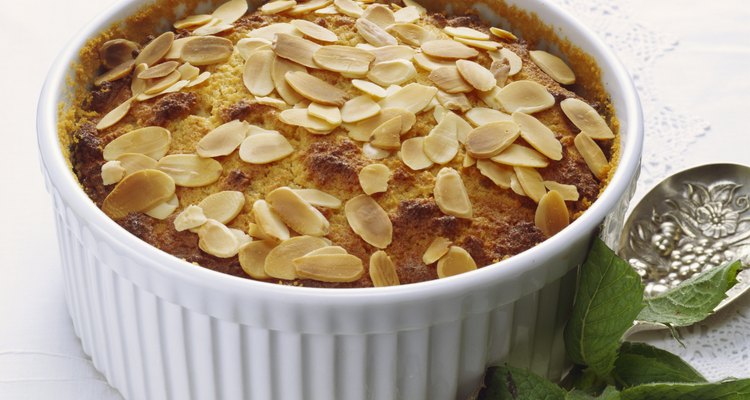
High-quality mixes make it possible for even the most infrequent and unskilled baker to produce an acceptable cake. Ordinarily, those mixes are baked in conventional aluminum cake pans, which transfer the oven's heat to the batter efficiently. If you seldom bake, or just don't have enough pans, you can usually use a suitably sized ceramic baking dish instead.
About Ceramics
From a scientist's perspective, anything from a glass measuring cup to a builder's brick is a form of ceramics. Your ceramic baking dishes are more specialized. That type of ceramic is made by firing mixtures of sand, clay, metal oxides and other substances at extremely high temperatures. The material can be shaped into an infinite number of forms, but food-related ceramic dishes fall into two broad categories. Thin-walled mixing bowls, cups and serving dishes aren't usually intended to take the heat of an oven. Thicker-walled baking dishes and casseroles are different, and can be used for baking cakes.
Thermal Shock
Ceramics are much less efficient than metals at transferring heat, which means they take longer to warm and are also slow to cool. That's why fireplaces are often lined and surrounded with bricks, to absorb the fire's heat and release it slowly after the fire goes out. For baking purposes, it means ceramics are prone to temperature shock. Thick-walled baking dishes heat evenly and slowly, but thin mixing or serving dishes are much more susceptible to differences in heat. If you put a cold dish in the oven, or an oven-hot dish on your cold counter, it might crack or break because of this "thermal shock."
Choosing Your Dish
If you have a casserole dish or ceramic baker that's a suitable size for your cake mix, you can use it because these dishes are designed to be oven-safe. Selecting a dish that's not intended for oven use is more problematic, but might be necessary if you wanted your cake to have a specific size and shape. The heaviest bowls are likeliest to survive, but it's always best to test before using one for your cake. Fill your dish with dried beans, barley or another dry ingredient that's easy to clean up. Place it in an oven preheated to 350 degrees Fahrenheit for 20 minutes, then remove it to a cooling rack. If it survives the test, it should bake your cake.
Baking Your Cake
Prepare the ceramic dish like any other cake pan, by oiling or spraying it and then dusting it lightly with flour. Lining the bottom with parchment can help your cake release from the pan more easily. Bake the cake according to its directions, but add five minutes to the baking time to allow for the ceramic baker's slow transmission of heat. At the end of that time if the cake isn't quite finished, give it an extra five minutes. The finished cake will have a lighter crust, because of the ceramic baker's poor heat conduction, and might not rise as high as it would in a metal pan.
Related Articles
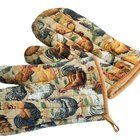
How to Cook Cake in a Glass Dish
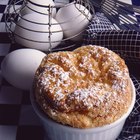
A Substitute for Souffle Pans

How to Lower Cooking Times & ...

Is Revere Ware Aluminum?
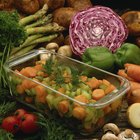
Can You Cook Frozen Dinners in Glass?
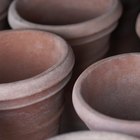
How to Bake Bread or Cake in Terra ...
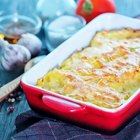
What Are the Benefits of Stoneware ...
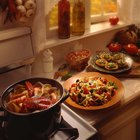
Characteristics of Oven-proof Plates

What Is Better for Cookware: Glass, ...
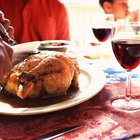
Can You Use a Glass Pan to Cook a Roast?

Can You Pour Boiling Water Into a ...
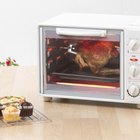
How to Bake With a Roaster
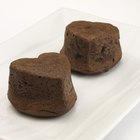
What Is a Souffle Dish?
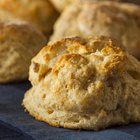
How to Keep Biscuits Warm in a Chafing ...

What Are the Types of Fine China?

How Long Do You Bake a Double Batch of ...

Does Heat Transfer Evenly Through ...
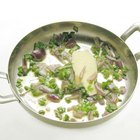
Are Nickel Lined Pans Safe?
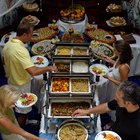
The Difference Between a Chafing Dish & ...
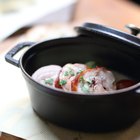
Dutch Oven Vs. Cooking Pot
References
- Cornell Center for Materials Research: What is Ceramic Made Of?
- On Food and Cooking: The Science and Lore of the Kitchen; Harold McGee
Writer Bio
Fred Decker is a trained chef and prolific freelance writer. In previous careers, he sold insurance and mutual funds, and was a longtime retailer. He was educated at Memorial University of Newfoundland and the Northern Alberta Institute of Technology. His articles have appeared on numerous home and garden sites including GoneOutdoors, TheNest and eHow.
Photo Credits
Eising/Photodisc/Getty Images